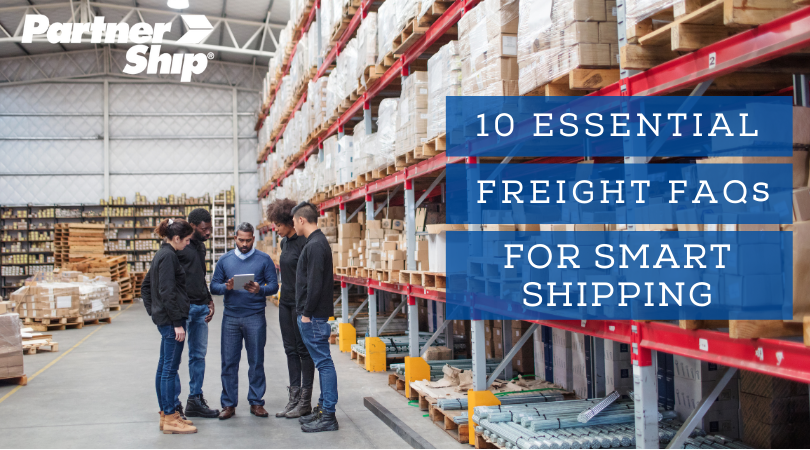10 Essential Freight FAQs for Smart Shipping
04/07/2021 — Jen Deming

No matter what you're moving, there are a few freight shipping fundamentals that you need to know in order to transport your load successfully. While the process seems straightforward, there are some challenges that can be anticipated by answering a few basic questions beforehand. We've compiled the essential questions that you need to be able to answer before you start shipping freight successfully.
What is the difference between freight and small package shipping?
While freight and small package shipping have some similarities, there are some major distinctions to keep in mind. Shipment size is the first recognizable difference between the two, with small package shipments being smaller, typically less than 150 lbs. Freight shipments consist of larger loads, often palletized, that range from one or two pieces to a dedicated truck. Differences in transit time, pricing structure, and driver service level are other major variables between the two transportation options. Knowing the details and requirements of your load can help determine which service makes the most sense for you.
What kind of packaging is best for my freight shipments?
Proper packaging is key in protecting the security of your shipments. Using the correct materials for the commodity you are moving can help deter damages and loss. When packing items into multiple boxes, avoid any excess space to limit shifting. Packaging materials like bubble wrap, foam cushioning, and packing peanuts can all help cushion your commodities. Freight shipments do best when boxes are palletized or packed securely into customized wooden crates. If you are shipping multiple items on a pallet, it’s important to shrink wrap them together in a uniform, structured stack to avoid damage or separation of items. Clear and correct labeling is important to get your shipments where they need to go accurately and in an efficient time frame.
When does it make sense to use LTL vs truckload?
Choosing to use either an LTL (less-than-truckload) freight or truckload service is often situational and can depend on the specific requirements of a shipment. LTL shipments are moved by carriers who group your loads together with other customers for delivery. Your shipment will be sharing space with other freight and will be handled at multiple terminals. Truckload shipments typically use a dedicated truck for your move, so you are paying for the entire space for the full length of the transit. LTL freight is a more cost-efficient option, and great for regular freight loads of a few pallets or more, with no hard deadlines. Truckload shipping gives you greater security and a faster transit, making it more ideal for large, high-value or fragile loads.
Do I need a guaranteed delivery date?
Getting your freight load delivery date guaranteed can be a tough endeavor, so arrival dates given at the time of booking your load are always estimated. Factors like weather, warehouse delays, traffic, and other variables make it difficult for a carrier to promise delivery on a certain date with standard freight services. Time-critical or expedited services are a viable option for shipments that must arrive quickly by a certain time of day, day of the week, or other specific delivery window. It’s important to note, however, that even when electing to use these premium services, situations may arise that can cause a delay where a carrier will not be liable.
What is an accessorial fee?
Freight carriers use additional charges to compensate for any extra time and effort it takes to move a shipment, called accessorial fees. Any challenges with loading and moving your freight such as an oversized shipment, limited access at the point of delivery, or specialized equipment needs can drive up your freight bill. It’s important to note that every carrier charges different amounts for these fees, so knowing what services your shipment requires before pickup will help avoid any surprises.
What do I do if my freight is damaged?
As frustrating as the experience can be, freight damage or loss is almost inevitable if you ship regularly. The cost of repairs and replacements can be compensated by the carrier in these circumstances, but there are very specific steps smart shippers must take to ensure approval and payouts. Damage prevention is always the smartest tactic, so proper packaging is a great place to start. Making sure your paperwork is in order, checking for hidden damages, and filing your claim in a timely manner are all important steps to ensure your claim is resolved in your favor.
What is a freight class?
Many factors go into determining a rate for a freight shipment, and freight class is one of the most important. Every type of commodity that moves through the freight network is assigned a universal classification code by the NMFTA. These numbers are determined by four main factors: density, stowability, handling, and liability. Generally, the more difficult or challenging a commodity is to move, the higher the freight class. These qualities, combined with the length of haul, fuel costs, and extra services, determine your final freight rate. Classification can be confusing to get right, but freight experts can help decide which works is most accurate for your load.
What is density-based freight?
As more freight enters the network, and capacity continues to be limited, carriers struggle to keep up with available loads. Ideal freight shipments are solid, heavy, and take up minimal space within the truck, allowing more room for additional loads. Lightweight, awkwardly-shaped loads that don’t allow for an efficient use of space are subject to density-based rates. The shipment density, combined with freight class, will give you your total freight rate, which tends to be higher than low-density, easy-to-move shipments.





